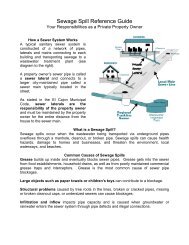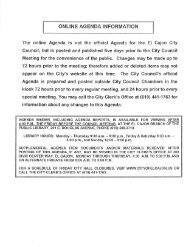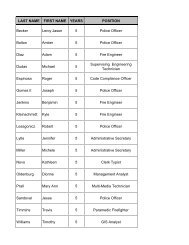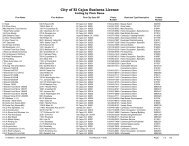CAJON SPEEDWAY TRACK HISTORY For forty ... - City of El Cajon
CAJON SPEEDWAY TRACK HISTORY For forty ... - City of El Cajon
CAJON SPEEDWAY TRACK HISTORY For forty ... - City of El Cajon
You also want an ePaper? Increase the reach of your titles
YUMPU automatically turns print PDFs into web optimized ePapers that Google loves.
Here are three <strong>of</strong> the top drivers during the super stock era at <strong>Cajon</strong> Speedway. Mike Hageman<br />
(2) leads Ron Esau (3) and Gary Crossland (4) in the middle <strong>of</strong> the third and fourth turns at the<br />
3/8 mile paved oval. Esau was the 1978 titlest. Hageman won three championships – 1979,<br />
1980, and 1986. Having finished second in points four times (1974, 1978, 1980, 1981) Crossland<br />
no doubt was “the best driver who never won a championship”.<br />
After several seasons the modifieds <strong>of</strong> SDRA gradually lost their following as the super stocks<br />
gained in popularity. In 1971 the super stocks became the sole tenants except for an occasional<br />
sprint car or midget show. <strong>Cajon</strong> Speedway ran but one race in 1972 as the county<br />
unsuccessfully sought to alter the terms <strong>of</strong> the lease.<br />
So on April 28, 1973 the super stocks returned to action on the Gillespie Field track after<br />
competing the previous year on the 1/2 mile dirt South Bay Park Speedway on Otay Mesa. The<br />
middle <strong>of</strong> the 1970's were the glory days for <strong>Cajon</strong> Speedway and the <strong>El</strong> <strong>Cajon</strong> Stock Car Racing<br />
Association as nearly 100 super stocks jammed the pits each Saturday night and competition<br />
was exceptionally tight. But that passed. By the mid‐1980's the super stock fields were thinning<br />
due to escalating costs and they too became history at the end <strong>of</strong> the 1988 season. They were<br />
replaced by the sportsman stocks, which was designed to be a more economical form <strong>of</strong> racing.<br />
That division is still the premier class on the track today, but shares the oval with the Grand<br />
American modifieds, street stocks, pony stocks, bomber stocks, and factory stocks.<br />
<strong>Cajon</strong> Speedway joined the NASCAR alliance prior to 1986 and today is one <strong>of</strong> about 100 short<br />
tracks across the nation participating in the weekly NASCAR Weekly Racing Series presented by<br />
Dodge.<br />
Since 1961 more than 3,965,000 fans have attended the racing events at <strong>Cajon</strong> Speedway,<br />
making the track one <strong>of</strong> the most successful and longest running race tracks on the west coast.<br />
There have been 1299 nights <strong>of</strong> oval track racing during those 43 years with 595 different<br />
drivers visiting victory lane following the 3195 main events. The Brucker clan continues to run<br />
the facility. Over the years Earle Brucker Jr. turned over the daily management chores to sons<br />
Steve and Kevin. Kevin is now responsible for the track's operation following the death <strong>of</strong> Steve<br />
Brucker, who was murdered in his home in April 2003. In 2003 nearly 67,000 fans attended the<br />
races during the season, an average <strong>of</strong> about 2560 per night.<br />
It certainly can be said the proposed baseball facility has come a long way.<br />
Thank you to Bob Gardner for providing this information and accompanying photos.










